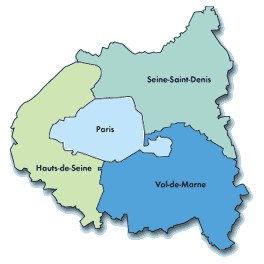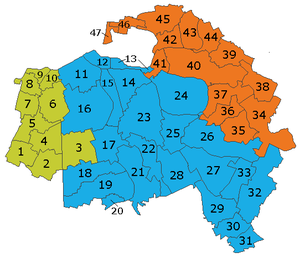Val-de-Marne
Val-de-Marne is a French department, named after the Marne River, located in the Île-de-France region. The department is situated to the southeast of the city of Paris.
Geography
Val-de-Marne is, together with Seine-Saint-Denis and Hauts-de-Seine, one of three small departments in Île-de-France that form a ring around Paris, known as the petite couronne (i.e. "inner ring").

Administration
Val-de-Marne is made up of 3 departmental arrondissements and 47 communes:

Arrondissement of
L'Haÿ-les-Roses |
Arrondissement of
Créteil |
Arrondissement of
Nogent-sur-Marne |
- Fresnes
- Rungis
- Thiais
- Chevilly-Larue
- L'Haÿ-les-Roses
- Villejuif
- Cachan
- Arcueil
- Gentilly
- Le Kremlin-Bicêtre
|
- Ivry-sur-Seine
- Charenton-le-Pont
- Saint-Maurice
- Maisons-Alfort
- Alfortville
- Vitry-sur-Seine
- Choisy-le-Roi
- Orly
- Villeneuve-le-Roi
- Ablon-sur-Seine
- Villeneuve-Saint-Georges
- Valenton
- Créteil
- Saint-Maur-des-Fossés
- Bonneuil-sur-Marne
- Sucy-en-Brie
- Boissy-Saint-Léger
- Limeil-Brévannes
- Villecresnes
- Mandres-les-Roses
- Périgny
- Santeny
- Marolles-en-Brie
|
- La Queue-en-Brie
- Noiseau
- Ormesson-sur-Marne
- Chennevières-sur-Marne
- Le Plessis-Trévise
- Villiers-sur-Marne
- Champigny-sur-Marne
- Joinville-le-Pont
- Nogent-sur-Marne
- Le Perreux-sur-Marne
- Bry-sur-Marne
- Fontenay-sous-Bois
- Vincennes
- Saint-Mandé
|
History
Val-de-Marne was largely part of the Seine department until 1968.
Demographics
Place of birth of residents
Place of birth of residents of Val-de-Marne in 1999
| Born in Metropolitan France |
Born outside Metropolitan France |
| 79.3% |
20.7% |
Born in
Overseas France |
Born in foreign countries with French citizenship at birth¹ |
EU-15 immigrants² |
Non-EU-15 immigrants |
| 2.1% |
3.3% |
4.8% |
10.5% |
¹This group is made up largely of pieds-noirs from Northwest Africa, followed by former colonial citizens who had French citizenship at birth (such as was often the case for the native elite in French colonies), and to a lesser extent foreign-born children of French expatriates. Note that a foreign country is understood as a country not part of France as of 1999, so a person born for example in 1950 in Algeria, when Algeria was an integral part of France, is nonetheless listed as a person born in a foreign country in French statistics.
²An immigrant is a person born in a foreign country not having French citizenship at birth. Note that an immigrant may have acquired French citizenship since moving to France, but is still considered an immigrant in French statistics. On the other hand, persons born in France with foreign citizenship (the children of immigrants) are not listed as immigrants. |
|
External links

